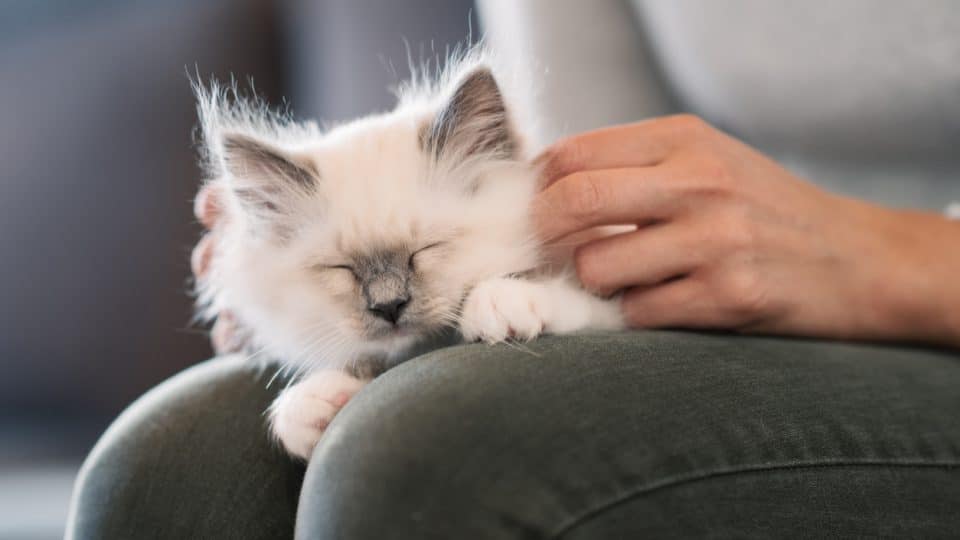Kneading, often called “making biscuits” or “baking bread,” is a common and adorable cat behaviour. Cats knead to feel calm, prepare cosy resting spots, and mark their territory, says Dr Preston Turano, a veterinarian and spokesperson for Felix Cat Insurance.
Keep reading as we dive into why cats knead, how it benefits them, and tips to guide your cat toward kneading on durable surfaces.
What Does Kneading Look & Feel Like
Kneading is when cats rhythmically push their front paws against soft surfaces like blankets, pillows, or laps—a motion reminiscent of kneading dough, earning it its endearing nickname.
This behaviour begins in kittenhood, as kittens knead their mother’s bellies to stimulate milk flow. In adulthood, it brings comfort and a sense of security.
Not all cats knead the same way, says Qiai Chong, the chief behaviourist at Pet Coach SG. “Some cats knead softly, while others may apply more pressure,” she explains.
Cats may knead their favourite humans, cosy blankets, or carpets, often paired with purring and a calm demeanour.
4 Reasons Cats Knead Humans
Kneading is a unique way cats communicate with the scent glands in their paws and toe beans. When your cat kneads you, it might mean affection, a need for attention, or a comforting ritual.
1. They love you
Kneading shows affection. It’s a sign your cat feels safe, loved, and content with you.
Experts suggest kneading may even release the bonding hormone oxytocin.
2. They want your attention
Kneading your lap or nearby often gets your attention—like petting or cuddling.
Positive reactions from you reinforce the behaviour, encouraging your cat to do it more.
3. They’re stressed
Kneading can be self-soothing, reminding cats of the comfort of nursing. “Kneading soft surfaces—including laps—helps cats feel secure,” Chong says.
If paired with stress signs like tail flicking or rapid breathing, they may be trying to calm themselves.
4. They’re in heat
Cats in heat often display unusual behaviors, including increased kneading.
They may also yowl at night or lift their hindquarters, showing heightened affection.
Why Do Cats Knead Blankets?
Besides making biscuits on us, cats often knead blankets for comfort, sometimes even sucking on the fabric for security.
- They’re marking territory. Cats have scent glands in their paw pads. By kneading, they release calming pheromones to “claim” the blanket as their own.
- They’re getting comfortable. Like fluffing pillows, cats knead to create a cosy nest. If they’re purring, blinking slowly, or have soft eyes, they’re content and prepping for a nap.
- They’re stretching the muscles. Kneading stretches a cat’s muscles, helping them stay flexible and active and keeping their limbs healthy.
Should You Stop Your Cat from Kneading?
It’s best to let your cat knead freely, as it provides comfort, relieves stress, and helps them communicate.
Avoid punishing your cat for kneading. Instead, encourage them to use designated surfaces, like a special blanket. Chong suggests using catnip or placing blankets in a cosy spot to make them more enticing.
If your cat kneads on inappropriate surfaces, gently redirect them with a fun toy or appropriate spot, rewarding them with delicious treats and praise.
Trimming your cat’s nails can prevent painful or destructive kneading. If needed, place a blanket between your cat and your lap.
Finally, you can create a calm environment if stress is a factor. “Provide quiet spaces, soft bedding, and avoid sudden changes in their routine,” Chong advises.
How to Encourage Safe & Comfortable Cat Kneading
To help your cat knead safely, create an environment where they can express this behaviour without causing harm. Chong suggests a few practical strategies:
- Set up a designated kneading area with blankets, pillows, or mats.
- Invest in cat-friendly bedding where your cat can knead without worry.
- Offer praise, affection, and treats when cats knead in the chosen area.
- Give your cat many different textures to knead on, like plush toys and soft fabrics.
- Make sure your cat feels comfortable by spending time with them, creating quiet spaces, and keeping a routine.



